同位语从句讲解
同位语从句讲解及练习

同位语从句一.同位语同位语:跟在名词或代词后,与之表达同一内容;通常由名词、名词性短语等担任。
(A=B:两项所指相同)e.g 我知道奥巴马,美国的总统。
I know Obama, the president of United States. (Obama与the president of US同一个人)我们应该从过去当中学习,它是现在的一面镜子和将来的希望。
We should learn from the past, the mirror of the present and the hope of the future.The future belongs to you, young people. 未来是属于你们年轻人的。
(you=young people) (实质是句中两个成分相等)二.同位语从句1.(1)概念:由一个句子来充当同位语。
e.g 我知道这个事实,奥巴马是美国的总统。
I know the fact that Obama is the president of United States. (the fact就是指的是奥巴马是美国总统)We should learn from the truth that the past is the mirror of the present and the hope of the future.(2)与从句同位的名词通常为抽象名词:fact, truth, Idea, thought, belief, hope, doubt, rumour, question, answer, reply, news, , order (有些抽象名词本身带有“疑问”的含义,如question, doubt)2. 构成:(------先造3个简单的句子,He is a student.(陈述句)Is he a student?(一般疑问句)Who is a student?(特殊疑问句)同位语从句(连词)不是与前面的抽象名词有关,连词取决于后面从句是什么样的形式;(I know the fact he is a student. )(1)如果从句是陈述句,连词用thate.g I know the fact that he is a student.我听到了这个消息,他离开了我们。
同位语从句的讲解以及练习高二

B. if
D. that
A English is being accepted 6. The fact ___
as an international language is known
to all.
A. that B. whether C. where D. if
名词性从句与写作
that 1. The news was very exciting ___ our class had won the football match. that are familiar with the opinion ____ all 2. They matter consists of atoms. where/when/whether 3. The question _____________________ we shall have a meeting hasn’t been decided. 4. They told the policeman the fact ___ they had that nothing to do with the murder.
随堂达标训练
A is , 1.He’s arriving next Saturday , ___
on November. A. that B. which C. it D. what
B 2. The suggestion has been put forward__ more middle school graduates should be admitted into universities.
3.Teenagers should not spend too much time online./ _____________________________________________ Many British parents hold the view. _______ Many British parents hold the view that teenagers shouldn’t spend too much time online.
同位语从句讲解与练习

同位语从句。
1.定义:用作同位语的从句叫做同位语从句。
2.用法:同位语从句的先行词多为fact, news, idea, thought, question, reply, report, remark等,关联词多用从属连词。
如: They were all very much worried over the fact that you were sick.对你生病这件事,他们都很焦虑。
Where did you get the idea that I could not come?你在哪儿听说我不能来?Early in the day came the news that Germany had declared war on Russia.德国已对俄国宣战的消息一大早就传来了。
注:同位语从句偶尔由从属连词whether引导。
如: I have no idea whether he’ll come or not.我不知道他是否来。
连接代词who, which, what和连接副词where,when, why, how亦可引导同位语从句。
The question who should do the work requires consideration.谁该干这项工作,这个问题需要考虑。
We haven’t yet settled the question where we are going to spend our summer vacation.到哪儿去度暑假,这个问题我们还没有决定。
It is a question how he did it.那是一个他如何做了此事的问题。
1.that引导的同位语从句与定语从句之区别 that引导的同位语从句 that引导的定语从句句法功能上that只起连接从句的作用,无意义。
在从句中不充当句子成分。
不可省。
that替代先行词在从句中不仅起连接作用,还充当一个句子成分。
同位语从句讲解及练习含答案
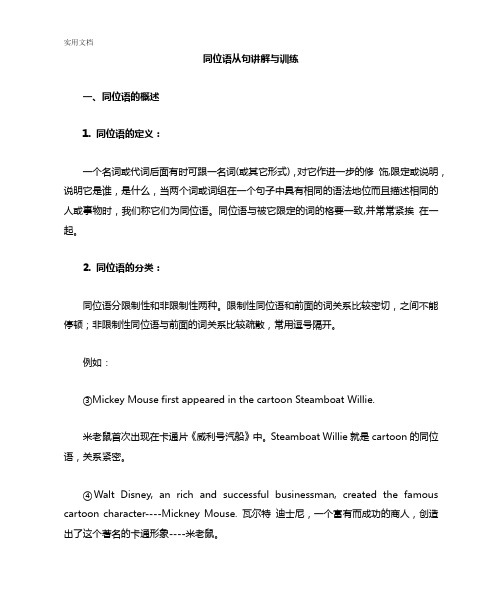
同位语从句讲解与训练一、同位语的概述1. 同位语的定义:一个名词或代词后面有时可跟一名词(或其它形式),对它作进一步的修饰,限定或说明,说明它是谁,是什么,当两个词或词组在一个句子中具有相同的语法地位而且描述相同的人或事物时,我们称它们为同位语。
同位语与被它限定的词的格要一致,并常常紧挨在一起。
2. 同位语的分类:同位语分限制性和非限制性两种。
限制性同位语和前面的词关系比较密切,之间不能停顿;非限制性同位语与前面的词关系比较疏散,常用逗号隔开。
例如:③Mickey Mouse first appeared in the cartoon Steamboat Willie.米老鼠首次出现在卡通片《威利号汽船》中。
Steamboat Willie就是cartoon的同位语,关系紧密。
④Walt Disney, an rich and successful businessman, created the famous cartoon character----Mickney Mouse. 瓦尔特迪士尼,一个富有而成功的商人,创造出了这个著名的卡通形象----米老鼠。
an rich and successful man 是主语Walt Disney的同位语,句子中有没有它,无所谓,不影响理解。
而且“瓦尔特迪士尼”是个“富有而成功的商人”,反过来,“一个富有而成功的商人”可不一定就是“瓦尔特迪士尼”。
3. 同位语的形式:(1)名词用作同位语时最多:①This is Mr.Brown,our Spanish teacher.这是我们的西班牙语老师布朗先生。
②“Leave it to me,”said Lao He,the man on night duty.值夜班的人老何说:“这事交给我。
”③You girls may take those seats over there.你们姑娘们可以坐在那边的座位上。
同位语从句——语法专题讲解

高中英语语法专题讲解专题二、同位语从句一、同位语从句概述同位语从句是用以解释说明某一名词内容の从句,常见の可以被同位语从句修饰の名词有:belief, chance, doubt, hope, idea, news, opinion, thought, promise等。
引导同位语从句の词有连词that, whether和副词how, when, where等。
二、同位语从句(1)同位语从句是意义完整の陈述句时,用连词that引导。
注:that在从句中不充当任何成分,只起连接作用,通常不省略。
eg:I got the news that he would come to see me the next week.(2)同位语从句是疑问句时,应根据语境选用who, when ,where, how, whether(不能用if)等词来引导。
eg:The question who is the best for the job requires consideration.(3)分隔式同位语从句:当主句の谓语较短,而同位语从句较长时,为了使句子保持平衡,常把同位语从句后置。
eg:An idea came to him that he could buy her a diamond ring.(4)后面常跟同位语の词有:doubt, fact, hope, idea, message, news, possibility, promise, question, suggestion,truth,thought,warning,wish等。
●注:advice, order, suggestion等词表示建议、命令の词后の同位语从句中の谓语动eg: that the meeting(should) be put off.三、同位语从句与定语从句の区别(1)所表达の内容不同:同位语从句和定语从句一般是放在某一名词后面,但同位语从句是对该名词の解释和说明,而定语从句是对该名词の修饰,说明它の性质特征。
同位语

It's my belief that once we've promised to keep a trust, we must tell lies to keep it.同位语从句用法讲解一、什么是同位语从句?同位语从句属于名词性从句,大多由从属连词that引导,常常跟在fact, idea, opinion, news, hope, belief等名词后面。
同位语从句一般用来解释或说明这些名词的具体含义或内容,在逻辑上表现为同位关系。
例如:They are familiar with the opinion that all matter consists of atoms.(们很熟悉这一观点,所有的物质都是由原子构成的)从先行词来看,同位语从句与名词之间在逻辑上是"主语+be+表语"的关系。
该名词是需要做特殊说明的抽象名词。
例如:They were delighted at the news that their team had won.(听到他们的球队赢了的消息时,他们欣喜若狂.)同位语从句:有时同位语从句与其先行词被其它成分分隔开来,这种分隔主要出于修辞原因,即为了保持句子结构平衡,避免头重脚轻。
例如:The whole truth came out at last that he was a wolf in sheep's clothing. (相终于大白了,他原来是只披着羊皮的狼。
)某些名词后的同位语从句中,其谓语动词应用虚拟语气形式:(should)+ 动词原形。
常见的名词有advice , idea , order , demand , plan,proposal,suggestion,request 等。
例如:The suggestion that a new bridge (should) be built was accepted.(建一座新桥的建议被采纳了。
同位语从句讲解
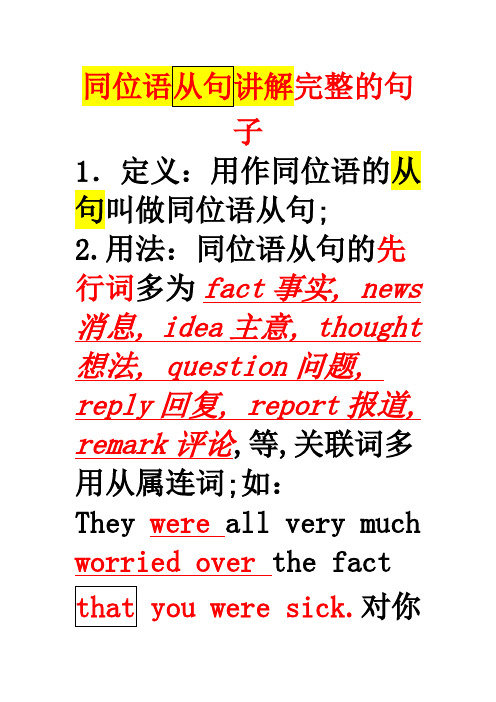
子1.定义:用作同位语的从句叫做同位语从句;2.用法:同位语从句的先行词多为fact事实, news 消息, idea主意, thought 想法, question问题, reply回复, report报道, remark评论,等,关联词多用从属连词;如:They were all very much worried over the fact对你生病这件事,Where did you get thecome你在哪儿听说我不能来Early in the day came the news that Germany had declared war on Russia.德国已对俄国宣战的消息一大早就传来了;DoubtWhat /how不在定从注:同位语从句偶尔由从属连词;如:I have no idea whether he’ll come or not.我不知道他是否来;连接代词同位语从句;The question who should do the work requires consideration.谁该干这项工作,这个问题需要考虑;同从We haven’t yet settled the question where we are going to spend our summer vacation.到哪儿去度暑假,这个问题我们还没有决定;It is a question how he did it.那是一个他如何做了此事的问题;1.that引导的同位语从句与定语从句之区别that引导的同位语从句that引导的定语从句句法功能上:that只起连接从句的作用,无意义;在从句中不充当句子成分,不可省,是同位语从句;。
高中英语语法,同位语从句的定义及用法分析

2023年高中英语语法同位语从句的定义及用法分析同位语从句的定义及用法分析从句是我们学习英语语法中必不可少的一项,也是很重要的知识点,有些同学对同位语从句不太了解,导致做题出现错误。
今天我们给大家带来的是同位语从句的讲解,同位语从句属于名词性从句中的一种,在复合句中充当同位语,故叫做同位语从句,用来解释说明其前面的名词。
一、具体定义在复合句中用作同位语的从句叫同位语从句,常常跟在fact, idea, opinion, news, hope, belief等名词后面,用以说明该名词表示的具体内容,可以由名词、代词、短语及句子来充当同位语从句。
二、用法1、从先行词来看同位语从句与名词之间该名词是需要做特殊说明的名词如idea, fact, news, hope, belief, suggestion, word, thought, doubt, truth, possibility, promise, order等有一定内涵的名词They were delighted at the news that their team had won.当听到他们的球队赢了的消息时,他们欣喜若狂。
2、同位语从句的功能与性质同位语从句是名词从句,其作用相当于一个名词,对前面抽象名词的进一步的说明和解释。
The news that our team has won the game was true. 我们队赢了那场比赛的消息是真的。
(补充说明news到底是一个什么消息?)3、从引导词that来看引导词that在同位语从句中是连词,只起连接作用,无具体词义,that不可省略The news that he will leave for Shanghai is true.他将要去上海的消息是真的.(that只起连接从句的作用,所以此句是同位语从句)4、引导词担当成分时的省略引导定语从句的关联词在从句中作宾语或状语时,可以省略或被其他词代替;介词+which同位语从句的引导词一般不能省略,更不能被代替,试比较:(1)The news that she heard is false. 她听到的消息是假的.(2)The news that she will go abroad is false. 她将出国这消息是假的.例(1)是定语从句,that可省略;例(2)是同位语从句,that不能省略。
同位语从句资料讲解

同位语从句同位语从句1.什么是同位语从句?在主从复合句中作同位语的从句称为同位语从句,常放在fact, news, idea, truth, hope, problem, information, wish,promise, answer, evidence, report, explanation, suggestion, conclusion等抽象名词后面,说明该名词的具体内容。
换言之,同位语从句和所修饰的名词在内容上为同一关系,对其内容作进一步说明。
例:The news that they had won the game soon spread over the whole school.他们比赛获胜的消息很快传遍了整个学校。
析:they had won the game说明The news的全部内容,因此该句为同位语从句。
2.引导词有哪些?怎么用?同位语从句一般用that, whether,what, which, who, when, where, why, how等词引导。
(补充:whether, what, how 不能引导定语从句,但可以用在同位语从句)补充:when,where 和 why 引导的定语从句和同位语从句之区别:when , where 和 why 作关系副词引导定语从句时,有跟它们含义相应的先行词,且先行词在从句中充当一定成分。
当 when , where 和 why作连接副词引导同位语从句时,则没有与它们含义相应的先行词。
所以,只要看先行词就可以判定了,若先行词和引导词关系密切,就是定从;只是修饰关系,就是同位语从句。
试比较:I'll never forget the day when ( = on which ) we met for the first time . ( 定语从句 )I have no idea when we met for the first time ( 同位语从句 )The office where ( = in which ) you work is here . ( 定语从句 )Then arose the question where we were to get so much money . ( 同位语从句 ) The reason why ( = for which ) he did not come is quite clear . ( 定语从句 )Xiao Wang has solved the problem why the TV was out of order . ( 同位语从句 )以上例句中 when , where 和 why 作关系副词引导定语从句时,可以改为“介词 + 关系代词 which ”来引导;而引导同位语从句的 when , where 和 why 就不能这样改。
同位语从句详细讲解PPT课件
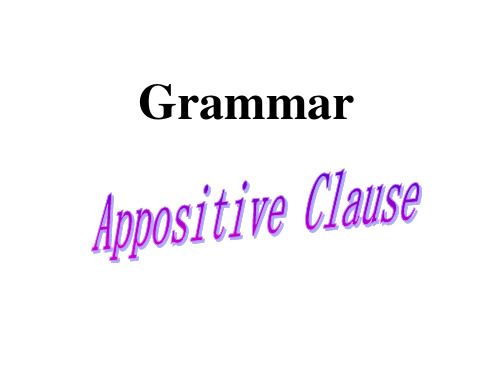
标题文本预设
此部分内容作为文字排版占位显示 (建议使用主题字体)
教学分析
单击添加文本单击添加文本单击添加文本单击添加文本单击添加文本单击添加文本单击添加文本单击添加文本单击添加文本单击添加文本单击添加文本单击添加文本单击添加文本单击添加文本单击添加文本单击添加文本单击添加文本单击添加文本
单击添加标题
What kind of noun clauses are they?
What it was to become was a mystery. 2. I don’t know who will help Henry to win the bet. 3. His trouble is that he doesn’t know anybody in London. 4. The fact that ships can go there surprises many people.
where
that
whom
3. The fact ____ she works hard is well known to us all.
that
4. Luckily, we'd brought a road map without ____ we would have lost our way.
同
定
③The reason why he was late for school sounds unreasonable.
④He has solved the problem why the radio didn’t work well.
定
同
I. 在空格处填上适当的词,使下列定语从句和同位语从句完整。
初中同位语从句详细讲解教师版
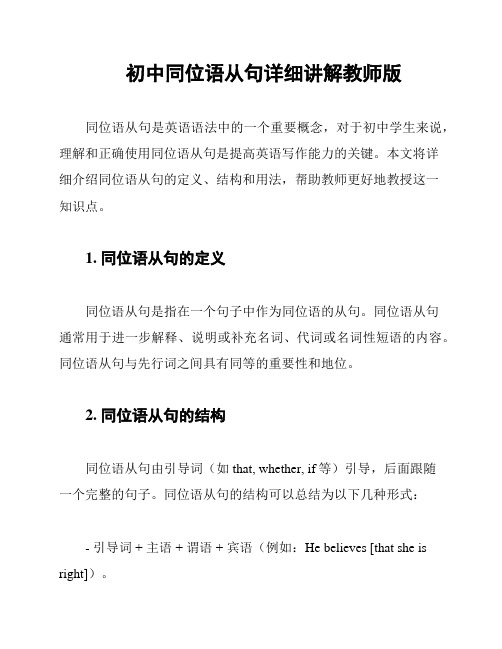
初中同位语从句详细讲解教师版同位语从句是英语语法中的一个重要概念,对于初中学生来说,理解和正确使用同位语从句是提高英语写作能力的关键。
本文将详细介绍同位语从句的定义、结构和用法,帮助教师更好地教授这一知识点。
1. 同位语从句的定义同位语从句是指在一个句子中作为同位语的从句。
同位语从句通常用于进一步解释、说明或补充名词、代词或名词性短语的内容。
同位语从句与先行词之间具有同等的重要性和地位。
2. 同位语从句的结构同位语从句由引导词(如that, whether, if等)引导,后面跟随一个完整的句子。
同位语从句的结构可以总结为以下几种形式:- 引导词 + 主语 + 谓语 + 宾语(例如:He believes [that she is right])。
- 引导词 + 主语 + 谓语 + 宾补(例如:I doubt [whether he can pass the exam])。
3. 同位语从句的用法同位语从句可以用于以下几种情况:3.1 解释或补充名词的含义同位语从句可以对先行词进行进一步解释或补充说明,使句子更加明确和具体。
例句:- The rumor [that they are getting married] is true(关于他们要结婚的传闻是真实的)。
3.2 表达观点、信念或想法同位语从句可以用于表达观点、信念或想法,进一步说明或支持先行词所表达的内容。
例句:- I have no doubt [that he will succeed](我毫不怀疑他会成功)。
- We all hope [that the weather will be good] tomorrow(我们都希望明天天气会好)。
3.3 引述或引用他人的话语同位语从句可以用于引述或引用他人的话语,表示间接引用的内容。
例句:- He asked [whether I had finished my homework](他问我是否已经完成作业)。
同位语从句讲解

同位语从句讲解同位语从句指的是在复合句中充当同位语的从句,可以对其前面的抽象名词做解释说明,属于名词性从句的范畴。
同位语从句的引导词为that,无含义,不充当成分,不可省略。
1. that引导同位语从句。
在下列名词后可用that引导同位语从句answer, belief, doubt, fact, hope, idea, information, knowledge, law, news, opinion, plan, suggestion, thought, truth等。
I had no idea that you were here.The story goes that William killed his wife.He always works hard in spite of the fact that he is not in good health.Suddenly the thought came to me that he would go blind.注意:①位语从句引导词that无含义,不充当成分,不可省略。
②同位语从句与其说明的名词或代词为同一内容,故可以用is把前边的中心词和从句连接成一个句子。
③同位语从句前一般没有逗号。
that引导同位语从句与引导定语从句的区别:that引导同位语从句时只起连接作用,不充当任何成分;that引导定语从句时,在从句中要作成分,如主语、宾语等。
①He told me the news that our team won.(that引导同位语从句)②The news that / which he told me was very exciting.(that引导定语从句,在从句中作宾语)2. 在no idea, question, problem等后可用wh-疑问词引导同位语从句,if不引导同位语从句。
I have no idea where he has gone.I have no idea what he said.3. 辨析:引导名词性从句时what与whatever, who与whoever 的区别:what 与whatever:What you want has been sent here.(what = the thing(s) that/all that/anything that特指)Whatever you want makes no difference to me.(whatever = anything that泛指)What caused the accident was a broken bottle.(特指)Whatever caused the accident has not yet been found.(泛指)who 与whoever:Who will go to Beijing on business has not been decided.(who表疑问,表示谁,哪一个)Whoever breaks the law should be punished.(whoever = anyone who,表示无论哪个人)4. 同位语从句注意与定语从句区别,同位语从句对前一名词做补充说明,在从句中无语法位置,而定语从句所修饰词在从句中占一语法位置如:The idea that one can do the work without thinking is wrong.(同位idea在从句中无位置,而从句只是具体说明idea的内容)The idea that you put forward at the meeting is wrong.(定语从句,idea做put forward 的宾语)。
同位语从句讲解(精品)

同位语从句一.定义在复合句中用作同位语的从句叫同位语从句。
它一般跟在某些名词后面,用以说明该名词表示的具体内容。
如:I heard the news that our team had won.我听到了我们队获胜的消息。
I had no idea that you were here.我不知道你在这里。
二.常见的可以跟同位语从句的词(抽象名词)news,idea,fact,promise,question,doubt,thought,hope,message,suggestion,word (消息),possibility等。
如:I’ve come from Mr wang with a message that he won’t be able to see you this afternoon.我从王先生那里来,他让我告诉你他今天下午不能来看你了。
三.常见引导词英语中引导同位语从句的词通常有连词that,whether,连接副词how,when,where等。
(注:if,which不能引导同位语从句。
)1.如同位语从句意义完整,应用that引导同位语从句。
(即that不充当任何成分,只起连接作用,不可省略)例:The general gave the order that the soldiers should cross the river at once.将军下达了战士们立即过河的命令。
析:the soldiers should cross the river at once是the order的全部内容,且意义完整,因此应用that引导同位语从句。
2.如同位语从句意义不完整,需增加"是否"的含义,应用whether引导同位语从句。
(if不能引导同位语从句)例:We'll discuss the problem whether the sports meeting will be held on time.我们将讨论运动会是否会如期举行的问题。
(完整版)语法:同位语从句讲解及习题
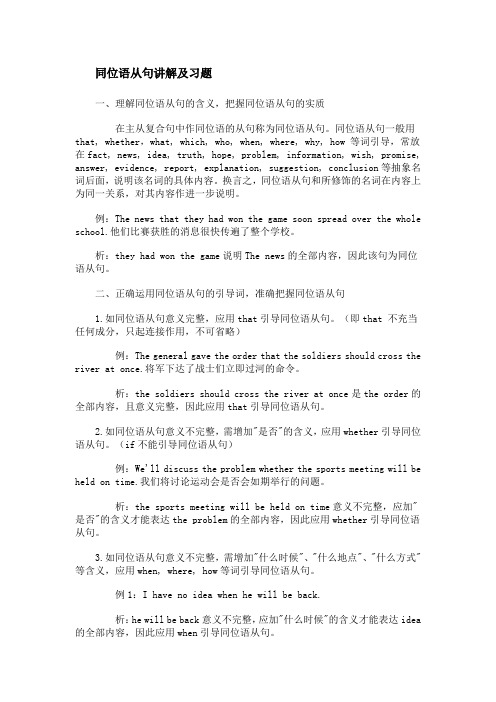
同位语从句讲解及习题一、理解同位语从句的含义,把握同位语从句的实质在主从复合句中作同位语的从句称为同位语从句。
同位语从句一般用that, whether,what, which, who, when, where, why, how 等词引导,常放在fact, news, idea, truth, hope, problem, information, wish, promise, answer, evidence, report, explanation, suggestion, conclusion等抽象名词后面,说明该名词的具体内容。
换言之,同位语从句和所修饰的名词在内容上为同一关系,对其内容作进一步说明。
例:The news that they had won the game soon spread over the whole school.他们比赛获胜的消息很快传遍了整个学校。
析:they had won the game说明The news的全部内容,因此该句为同位语从句。
二、正确运用同位语从句的引导词,准确把握同位语从句1.如同位语从句意义完整,应用that引导同位语从句。
(即that 不充当任何成分,只起连接作用,不可省略)例:The general gave the order that the soldiers should cross the river at once.将军下达了战士们立即过河的命令。
析:the soldiers should cross the river at once是the order的全部内容,且意义完整,因此应用that引导同位语从句。
2.如同位语从句意义不完整,需增加"是否"的含义,应用whether引导同位语从句。
(if不能引导同位语从句)例:We'll discuss the problem whether the sports meeting will be held on time.我们将讨论运动会是否会如期举行的问题。
同位语从句用法详解(含同位语从句与定语从句的区别讲解)
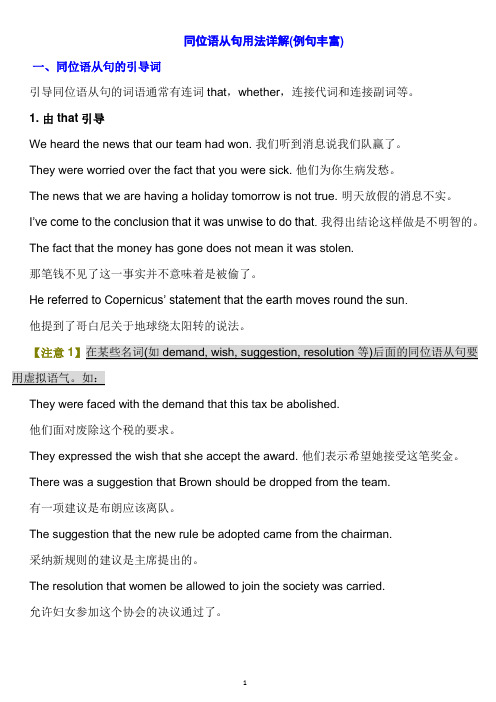
同位语从句用法详解(例句丰富)一、同位语从句的引导词引导同位语从句的词语通常有连词that,whether,连接代词和连接副词等。
1. 由that引导We heard the news that our team had won. 我们听到消息说我们队赢了。
They were worried over the fact that you were sick. 他们为你生病发愁。
The news that we are having a holiday tomorrow is not true. 明天放假的消息不实。
I’ve come to the conclusion that it was unwise to do that.我得出结论这样做是不明智的。
The fact that the money has gone does not mean it was stolen.那笔钱不见了这一事实并不意味着是被偷了。
He referred to Copernicus’ statement that the earth moves round the sun.他提到了哥白尼关于地球绕太阳转的说法。
【注意1】在某些名词(如demand, wish, suggestion, resolution等)后面的同位语从句要用虚拟语气。
如:They were faced with the demand that this tax be abolished.他们面对废除这个税的要求。
They expressed the wish that she accept the award. 他们表示希望她接受这笔奖金。
There was a suggestion that Brown should be dropped from the team.有一项建议是布朗应该离队。
The suggestion that the new rule be adopted came from the chairman.采纳新规则的建议是主席提出的。
同位语从句以及讲解

同位语从句一、理解同位语从句的含义,把握同位语从句的实质在主从复合句中作同位语的从句称为同位语从句。
同位语从句一般用that, whether,what, which, who, when, where, why, how 等词引导,常放在fact, news, idea, truth, hope, problem, information, wish,promise, answer, evidence, report, explanation, suggestion, conclusion等抽象名词后面,说明该名词的具体内容。
换言之,同位语从句和所修饰的名词在内容上为同一关系,对其内容作进一步说明。
例:The news that they had won the game soon spread over the whole school.他们比赛获胜的消息很快传遍了整个学校。
析:they had won the game说明The news的全部内容,因此该句为同位语从句。
二、正确运用同位语从句的引导词,准确把握同位语从句1.如同位语从句意义完整,应用that引导同位语从句。
(即that 不充当任何成分,只起连接作用,不可省略)例:The general gave the order that the soldiers should cross the river at once.将军下达了战士们立即过河的命令。
2.如同位语从句意义不完整,需增加"是否"的含义,应用whether引导同位语从句。
(if 不能引导同位语从句)例:We'll discuss the problem whether the sports meeting will be held on time.我们将讨论运动会是否会如期举行的问题。
析:the sports meeting will be held on time意义不完整,应加"是否"的含义才能表达the problem的全部内容,因此应用whether引导同位语从句。
同位语从句讲解

同位语从句讲解就是名词性从句(主语从句、表语从句、宾语从句、同位语从句)中的主要从句之一,从句作同位语表示与之同位的名词(短语)的实际内容,它的作用相当于名词,对前面的名词(短语)加以补充说明或进一步解释,相当于一个表语从句,它们之间的关系就是同位关系,即主表关系。
详细信息一个名词(或其它形式)对另一个名词或代词进行修饰,限定或说明,这个名词(或其它形式)就就是同位语。
同位语与被它限定的词的格要一致,并常常紧挨在一起。
1、名词作同位语Mr Wang, my chi ld’s teacher, will be visiting us on Tuesday、王先生,我孩子的老师,星期二要来瞧我们。
2、短语作同位语I, the oldest girl in the family, always had to care for the other children、我,作为家里最大的女孩,老得照料家中的其她孩子。
3、直接引语作同位语But now the question comes to their minds, “Did she die young because she was a clone?”但就是现在她们不得不思考这样的问题:“多莉早死就是因为它就是一只克隆羊不?” 4、句子作同位语The girls were surprised at the fact that ocean ships can sail up the Great lakes、巨大的海轮可以开到五大湖,让表姐妹俩感到吃惊。
同位语从句用法同位语部分就是个句子,就就是同位语从句,这种用法比较"固定"一、在复合句中用作同位语的从句叫同位语从句。
它一般跟在某些名词后面,用以说明该名词表示的具体内容。
I heard the news that our team had won.我听到了我们队获胜的消息。
二、可以跟同位语从句的名词通常有news,idea,fact,promise,question,doubt,thought,hope,message,suggestion,words(消息),possibility等。
- 1、下载文档前请自行甄别文档内容的完整性,平台不提供额外的编辑、内容补充、找答案等附加服务。
- 2、"仅部分预览"的文档,不可在线预览部分如存在完整性等问题,可反馈申请退款(可完整预览的文档不适用该条件!)。
- 3、如文档侵犯您的权益,请联系客服反馈,我们会尽快为您处理(人工客服工作时间:9:00-18:30)。
初中英语语法同位语从句专项讲解与训练
(一) 概念
一般来说,在主从复合句中,用作同位语的从句叫同位语从句。
它通常跟在某些名词之后,用以说明或解释该名词表示的具体内容。
可以跟同位语从句的名词通常有:
advice, decision, fact, hope, idea, information, mess age, news, promise, proposal, reply, report, suggesti on, word(消息),problem,question, doubt, thought 等。
例如:
They were delighted at the news that their team ha d won.
当听到他们队获胜的消息时,他们欣喜若狂。
Where did you get the idea that I could not come ?你从哪儿听说我不能来?
有时同位语从句可以不紧跟在被说明的名词后面,而被别的词隔开。
如:
The thought came to him that Tom might have return ed the book.
他突然想起汤姆可能已经还了书了。
(二)引导词
请仔细观察下列句子,注意从句引导词的用法。
1. The news that Mr. Li will be our new English teacher is true.
2. He hasn’t made the decision whether he will go there.
3. The question who should do the work is being d iscussed at the meeting
4. I have no idea what the boy is doing in the next room now.
5. We haven’t yet settled the question where we a re going to spend our summer vacation this year.
6. I have no idea how I can get to the railway station.
7. I have no idea when he will be back.
[小结归纳]
①that引导同位语从句时无词义,也不充当任何成分,但通常不可以省略,如句1;
②whether引导同位语从句时意为“是否”,通常不能用if来代替,如句2;
③连接代词who, what等可以引导同位语从句,如句3,4;
④连接副词where, how, when等可以引导同位语从句,如句5,6,7。
(三) that 引导的同位语从句和定语从句
①意义不同:同位语从句用来进一步说明前面名词的内容;而定语从句用来修饰、限定前面的先行词。
试比较:
1. The news that our team has won the final matc
h is encouraging.
2. The news that you told us is really encouragin g.
[分析] 句1中that引导同位语从句,说明“news”的内容:我们队取得了决赛胜利。
句2中that引导定语从句,对“news”加以限定:是你告诉我们的,而非来自其他渠道。
②that的功能不同:that引导同位语从句时是一个纯连词,不充当任何成分;而引导定语从句时,不仅起连接作用,而且还指代先行词并在从句中充当主语、宾语等成分。
试比较:
1. Dad made a promise that he would buy me a CD player if I passed the English test.
2. Dad made a promise that excited all his childr en.
[分析] 句1中that引导同位语从句,其中that无词义,也不充当任何成分;句2中that引导定语从句,that指代promise,又在从句中充当主语,且that可以用which替换。
③可否省略:that在引导同位语从句时,通常不可省略。
在引导定语从句时,若在从句中作宾语,通常可以省略,若作主语则不可以省略。
[即学即用]
I.请用适当的词填空,使下列句子意思完整。
1. They expressed the hope _______ they would come over to China soon.
2. The fact _______ he didn’t see Tom this mornin
g is true.
3. Word has come _______ some American guests will come to our colle-ge for a visit next week.
4. He can’t answer the question _______ he got th
e money from his home yesterday.
5. Do you have any idea _______ is actually going on in the classroom?
6. The problem _______ we should have the meeting in the hall now must be decided at once.
II. 下列各句中均有一处错误,请改正。
1. Our team has won the game, that made us very happy.
2. I’ve come with a message from Mr Wang how he won’t be able to see you this afternoon.
3. He must answer the question if he agrees with what she said or not.
4. I’ve read the book where you gave me the day before yesterday.
5. One of the men held the pinion when what the book said was right.
III.把下列句子翻译成英语。
1. 我向他许诺说我一到北京就给他写信。
2. 他经常问我这个问题,那就是这个工作是否值得做。
3. 他什么也不说,这一事实使大家都感到惊奇。
4. 在我看来,他刚才告诉我的这个消息是真实的。
5. 他突然想起他本来应该去接儿子的。
Key:
I. 1. that 2. that 3. that 4. how 5. what
6. whether
II. 1 that→which 2. how→that 3. if→whether
4. where→that/ which或省略where
5. when→that
6. that→how
III. 1. I made a promise that I would write to h im as soon as I got to Beijing.
2. He often asked me the question whether the work was worth doing.
3. The fact that he had not said anything surprise
d everybody.
4. In my opinion, the news (that / which) he told me just now is true.
5. A thought suddenly came to him that he should have picked up his son.。
